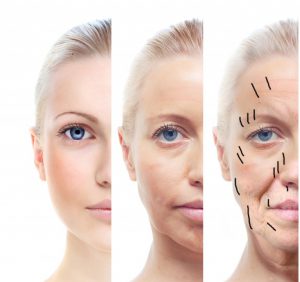A recent peer reviewed study examined how your position during sleep may contribute to facial wrinkles. While sleeping, certain positions place the face in contact with your pillow that causes stretch, shear, and compression forces on your skin, which causing the skin to buckle eventually causing sleep wrinkles. The lateral sleep position (on your side) and the prone (face down in the pillow) position are considered the positions most likely to cause sleep wrinkles. Although no one remains in the same position during the night, the number of “position shifts” during the night does decrease with aging, from 27 to 16. The reduced number of “postion shifts”, unfortunately, results in a longer amount of time in one positon, therein a longer duration of time a wrinkle producing force is being applied to an area of skin.
The location and orientation of sleep wrinkles are often different than wrinkles caused by facial expression (See figure. Common sleep wrinkle locations and orientation marked in black).

And unlike wrinkles caused by facial expression most sleep wrinkles are not improved by our Botox in Orange County. However, sleep wrinkles can be improved by facial fillers (e.g., Juvederm, Restylane, Belotero), laser resurfacing and face-lifting in some cases.
To minimize sleep wrinkles, patients should focus on keeping their skin healthy. Contributing factors to wrinkle formation are, of course, smoking and sun exposure, but dry skin and the pH of your skin are important components too (in general, optimal pH is about 5.5). Hence, the importance of using sunscreens, moisturizers and toners, and obtaining skin care advice from qualified medical aestheticians. Lastly, to reduce the emergence of sleep wrinkles during the night, some authors suggest using specialty pillows to limit facial distortion during sleep (e.g. JuveRest pillow), but studies showing these types of pillows truly work are needed.
Timothy R. Miller, M.D.


